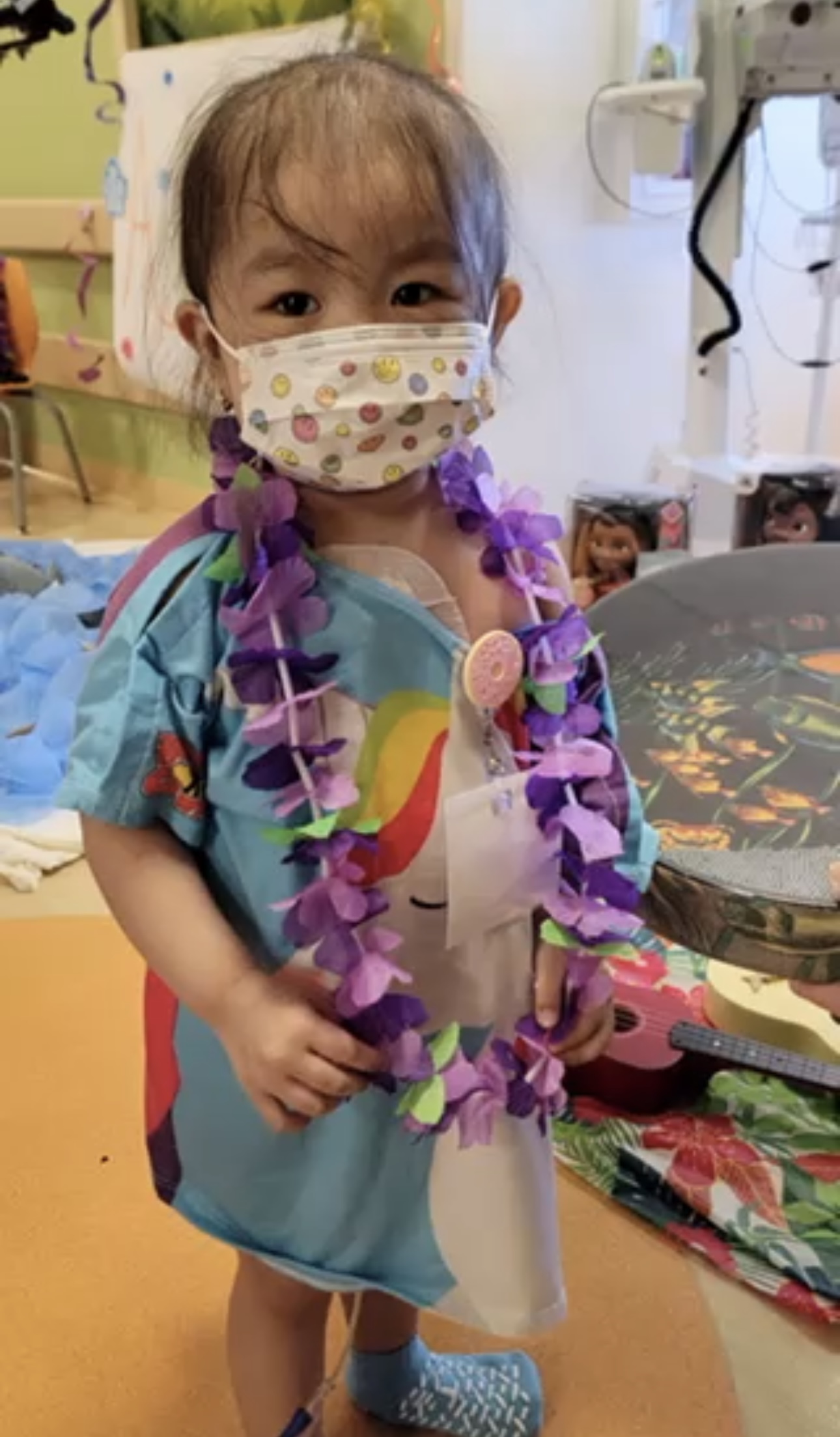The Healing Power of Music: Lola's Journey Through Pediatric Oncology
In the challenging world of pediatric oncology, the spirit of young patients often shines brightly, illuminating their path through adversity. One such story is that of Ellora "Lola" Yang, a vibrant two-year-old whose journey exemplifies resilience and the transformative power of music therapy.
Lola's Story: Finding Joy Amidst the Storm
Lola is a sassy, independent two-year-old whose full-of-life personality makes everyone in the room giggle. She is a very special child—her parents’ miracle rainbow baby after seven years of infertility—and a nurturing big sister to her baby sister, Klaira. On January 2, 2024, just days after Christmas, Lola and her parents rushed overnight to the nearest children's hospital, an hour away. Lola was experiencing symptoms that worried her parents: fatigue, loss of appetite, unexplainable bruises, petechiae (small spots of bleeding under the skin), dark sunken under eyes, and a pale complexion. After seeing a video from another parent outlining leukemia symptoms on social media, they recognized these same signs in Lola and acted quickly. Initially, doctors diagnosed her with an autoimmune disorder called Immune Thrombocytopenic Purpura (ITP), but further bloodwork, bone marrow biopsies, and lumbar punctures confirmed the diagnosis of B cell lymphocytic leukemia.
 Lola started her first phase of treatment immediately, and her hospital stay lasted 29 days. After undergoing surgery to have a G-tube placed for medication, she was finally able to go home. However, her battle continued with several subsequent hospitalizations due to high fevers and a weakened immune system. Lola's vibrant personality dimmed as she endured painful procedures and treatments. Her parents watched in anguish as their joyful daughter became irritable and withdrawn. However, everything changed when a music therapist knocked on their door. The moment music filled the room, Lola blossomed back into her cheerful self. Engaging with egg shakers, xylophones, and ukuleles, she transformed her hospital experience into instrument games, silly singing, and playful, imaginative “cooking sessions.” These moments provided her not only with distraction but also a source of emotional release and connection. During all of her subsequent hospital stays, Lola found comfort and excitement through the music therapy team.
Lola started her first phase of treatment immediately, and her hospital stay lasted 29 days. After undergoing surgery to have a G-tube placed for medication, she was finally able to go home. However, her battle continued with several subsequent hospitalizations due to high fevers and a weakened immune system. Lola's vibrant personality dimmed as she endured painful procedures and treatments. Her parents watched in anguish as their joyful daughter became irritable and withdrawn. However, everything changed when a music therapist knocked on their door. The moment music filled the room, Lola blossomed back into her cheerful self. Engaging with egg shakers, xylophones, and ukuleles, she transformed her hospital experience into instrument games, silly singing, and playful, imaginative “cooking sessions.” These moments provided her not only with distraction but also a source of emotional release and connection. During all of her subsequent hospital stays, Lola found comfort and excitement through the music therapy team.
Lola is currently progressing through the final phase of frontline chemotherapy and entered the maintenance phase in October. She continues to shine and stay positive through this whole journey.
Excerpts provided by Lola's family
The Essential Role of Music Therapy in Pediatric Care
Extensive research, new and old, highlights the critical role of music therapy in pediatric settings. A study published in Pediatrics medical journal found that children who received music therapy reported significantly lower levels of anxiety and pain during hospitalization (Bradt & Dileo, 2014). Additionally, a survey of pediatric oncology patients revealed that 85% felt music therapy improved their mood and overall hospital experience (Sullivan et al., 2015). Furthermore, approximately 70% of children's hospitals in the United States now incorporate music therapy programs, underscoring its importance in holistic patient care (American Music Therapy Association, 2020).
Lola’s journey highlights the importance of music therapy for pediatric patients, particularly those facing extensive hospital stays. Here are some key benefits:
-
Emotional Support: Music therapy provides a safe space for children to express their feelings, which is crucial for emotional regulation during stressful medical experiences. A study published in Journal of Pediatric Psychology found that music therapy significantly reduced anxiety levels in hospitalized children, fostering a sense of security and emotional well-being (Geretsegger et al., 2014). By allowing patients to engage in creative expression, music therapy helps them process their emotions and cope with the challenges of treatment.
-
Pain Management: Engaging with music has been shown to reduce the perception of pain and discomfort. According to a meta-analysis in Pain Management Nursing, music therapy can lead to significant decreases in pain levels for pediatric patients undergoing medical procedures (Huang et al., 2015). The rhythmic and melodic elements of music can distract children from pain and provide a more positive focus during challenging times. Furthermore, the release of endorphins during music engagement helps enhance overall comfort.
-
Cognitive and Developmental Benefits: Music therapy supports cognitive development, encouraging skills such as memory, attention, and communication. Research indicates that music can stimulate brain activity and enhance learning capacities in children (Schellenberg, 2004). For young patients like Lola, engaging in music therapy can foster developmental progress, especially when their medical conditions limit other opportunities for growth.
-
Social Connection: Music therapy fosters connections with therapists, peers, and family members, reinforcing essential support systems. A study in Child: Care, Health and Development highlighted that music therapy can improve social interactions among hospitalized children, facilitating friendships and emotional bonds that are vital during treatment (Davis et al., 2014). For Lola, these connections helped her maintain relationships and share joyful experiences with her loved ones, promoting a sense of community during her hospital stays.
-
Reducing Medical Trauma: Hospitalization can be traumatic for children, leading to lasting psychological effects. Music therapy has been shown to reduce the incidence of medical trauma by providing a comforting and engaging environment. A study in Journal of Trauma & Dissociation found that children who participated in music therapy after invasive medical procedures reported lower levels of post-traumatic stress symptoms compared to those who did not receive such interventions (Shin et al., 2018). By helping children manage their experiences and emotions, music therapy can play a crucial role in mitigating the psychological impact of medical trauma.
-
Enhanced Coping Skills: Music therapy equips children with coping mechanisms that they can use both in the hospital and beyond. Engaging in music activities teaches children to express their feelings creatively and develop resilience in the face of adversity. According to research published in Psychosocial Oncology, children who participated in music therapy reported increased coping skills and a better ability to manage stress and anxiety related to their illness (Farrugia et al., 2017).

Empowering Others Through Sharing
As Lola continues her journey through treatment, her parents feel empowered to share her story online, hoping to help other families facing similar challenges. By creating a community around this issue, they aim to show others that they are not alone in their struggles. Lola’s story serves as a powerful reminder of the impact that music can have on healing and the importance of raising awareness about pediatric cancer.
In pediatric oncology, where hope can often feel distant, music therapy stands as a beacon of light. Advocating for its integration into pediatric care is crucial. By addressing the emotional, psychological, and physical needs of young patients, we can ensure that every child receives compassionate, holistic care. Lola’s journey exemplifies the resilience of the human spirit, showing us that even in the face of adversity, joy can be rediscovered through the power of music.
References
-
American Music Therapy Association. (2020). Music Therapy in Pediatric Hospitals: An Overview.
-
Bradt, J., & Dileo, C. (2014). Music interventions for mechanically ventilated patients. Cochrane Database of Systematic Reviews, (12).
-
Davis, B. L., et al. (2014). Music therapy: Improving socialization and emotional expression in children. Child: Care, Health and Development, 40(1), 48-56.
-
Farrugia, R., et al. (2017). The effectiveness of music therapy in pediatric oncology: A systematic review. Psychosocial Oncology, 35(1), 43-55.
-
Geretsegger, M., et al. (2014). Music therapy for children with behavioral and emotional problems: A randomized controlled trial. Journal of Pediatric Psychology, 39(2), 169-180.
-
Huang, C. H., et al. (2015). The effectiveness of music therapy on pain reduction in pediatric patients: A systematic review and meta-analysis. Pain Management Nursing, 16(6), 890-902.
-
Schellenberg, E. G. (2004). Music lessons enhance IQ. Psychological Science, 15(8), 511-514.
-
Shin, H. S., et al. (2018). The role of music therapy in the prevention of post-traumatic stress symptoms in children after invasive medical procedures. Journal of Trauma & Dissociation, 19(4), 442-455.
-
Sullivan, K., et al. (2015). The impact of music therapy on pediatric patients: A systematic review. Journal of Pediatric Nursing, 30(6), e7-e13.
Written by Emily Fjelstrom, MT-BC


